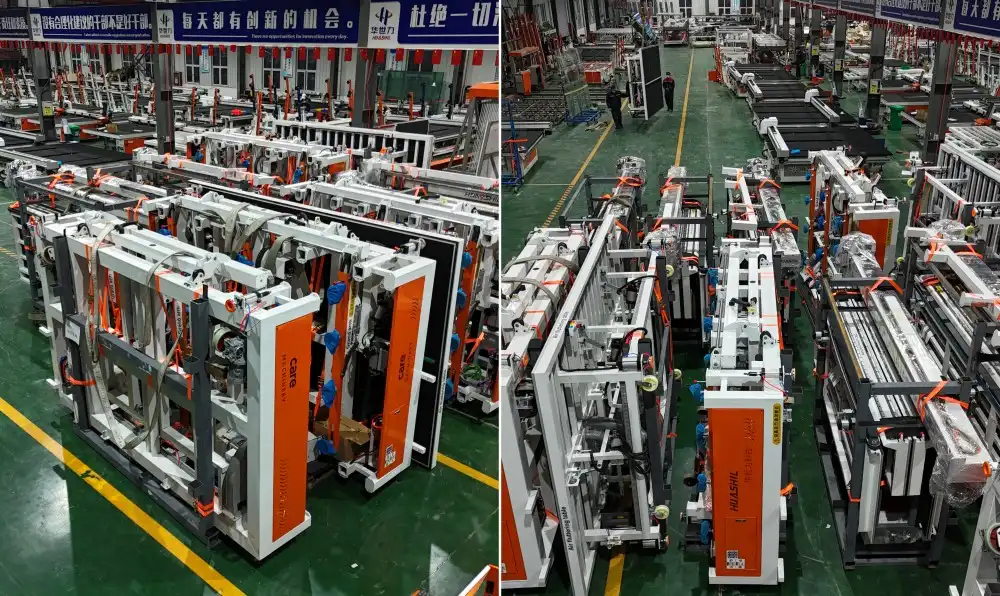In the world of stained glass artistry, the choice between portable and stationary cutting machines can significantly impact an artist's workflow and creativity. This decision is crucial for both hobbyists and professional craftsmen alike. Portable stained glass cutting machines offer flexibility and convenience, allowing artists to work on-site or in various locations. They are typically lightweight and compact, making them ideal for those with limited workspace or who need to transport their equipment frequently. On the other hand, stationary stained glass cutting machines are known for their stability, precision, and ability to handle larger projects. These machines are often more powerful and can accommodate a wider range of glass thicknesses and sizes. Understanding the differences between these two types of machines is essential for anyone looking to invest in stained glass cutting equipment, as it can affect productivity, quality of work, and overall satisfaction with the creative process.
What are the key features to look for in a stained glass cutting machine?
Cutting Precision and Accuracy

When selecting a stained glass cutting machine, precision and accuracy are paramount. High-quality machines, such as the HSL-YTJ3829 model, offer automatic edge finding and pressure control systems. These features ensure flawless cuts, even for intricate stained glass designs. The machine's ability to maintain consistent pressure throughout the cutting process is crucial for achieving clean, precise lines. Additionally, advanced stained glass cutting machines often incorporate optimization software like Optima, which calculates the most efficient cutting paths. This not only improves accuracy but also reduces waste and increases yield, making it an essential feature for both hobbyists and professional workshops.
Glass Size Capacity and Thickness Range
The glass size capacity and thickness range of a stained glass cutting machine are critical factors to consider. For instance, the HSL-YTJ3829 model can handle glass sizes up to 3660*2800mm, making it suitable for large-scale projects. The ability to cut glass with thicknesses ranging from 2 to 19mm provides versatility for various applications. When choosing a stained glass cutting machine, it's important to assess your typical project requirements and future needs. A machine with a wider range of capabilities can adapt to different project demands, from delicate decorative pieces to robust architectural installations. Consider whether you'll need to work with specialty glass types, such as Low-E glass, as some machines offer additional features like Low-E film removal.
Automation and Control Features
Modern stained glass cutting machines offer a range of automation and control features that enhance efficiency and ease of use. The HSL-YTJ3829, for example, boasts automatic loading and an air flotation system, which protect glass surfaces during transport and handling. A 360-degree remote control walking feature allows for easy operation, especially when working with large format glass. Automation in pressure control and edge finding not only improves accuracy but also reduces the physical strain on the operator. When evaluating stained glass cutting machines, look for Industry 4.0 ready features that provide automated workflows and real-time data monitoring. These advanced capabilities can significantly streamline production processes and help maintain consistent quality across projects.
How do portable and stationary stained glass cutting machines differ in terms of workspace requirements?
Footprint and Space Considerations
The footprint of a stained glass cutting machine is a crucial factor, especially for artists with limited workspace. Portable machines are designed to be compact and easy to store, making them ideal for small studios or home workshops. They often have foldable components or detachable parts that allow for easy storage when not in use. In contrast, stationary machines like the HSL-YTJ3829, with dimensions of 6400*5100mm, require a dedicated workspace. These larger machines are better suited for professional workshops or studios with ample space. When considering a stained glass cutting machine, it's essential to measure your available workspace and account for additional area needed for material storage, glass handling, and operator movement.

Power and Infrastructure Requirements
Power and infrastructure requirements differ significantly between portable and stationary stained glass cutting machines. Portable machines are often designed to run on standard household electricity, making them versatile and easy to set up in various locations. They may have lower power consumption, which is beneficial for energy efficiency and operating costs. Stationary machines, particularly those with advanced features like the HSL-YTJ3829, may require specialized electrical setups, including three-phase power or higher voltage capabilities. Additionally, stationary machines might need compressed air systems for features like air flotation, which requires planning for air compressor placement and ducting. When choosing between portable and stationary options, consider not only the immediate power needs but also the long-term infrastructure implications for your workspace.
Mobility and Transportation Considerations
Mobility is a key differentiator between portable and stationary stained glass cutting machines. Portable machines are designed for easy transportation, often featuring lightweight materials and modular designs that can be quickly disassembled and reassembled. This makes them ideal for artists who work on-site or participate in craft fairs and exhibitions. Some portable models even come with carrying cases or wheels for enhanced mobility. Stationary machines, while offering greater stability and capacity, are not intended for frequent relocation. Moving a machine like the HSL-YTJ3829 requires careful planning, specialized equipment, and often professional assistance. For businesses that may need to relocate or rearrange their workshop, the immobility of stationary machines should be factored into long-term planning and space allocation decisions.
What are the cost implications of choosing between portable and stationary stained glass cutting machines?
Initial Investment and Long-term Value
The initial investment for stained glass cutting machines varies significantly between portable and stationary options. Portable machines generally have a lower upfront cost, making them more accessible to hobbyists or small-scale artists. However, they may have limitations in terms of capacity and features. Stationary machines like the HSL-YTJ3829 represent a larger initial investment but offer advanced features such as automatic loading, pressure control, and edge finding. These features can lead to increased productivity and precision, potentially providing better long-term value for professional workshops. When evaluating the cost, it's crucial to consider the machine's lifespan, capacity, and potential for increased output. High-quality stationary machines often come with certifications like CE and ISO9001, ensuring compliance with international standards and potentially offering better resale value.
Operational Costs and Maintenance
Operational costs and maintenance requirements differ between portable and stationary stained glass cutting machines. Portable machines typically have lower operational costs due to their smaller size and simpler mechanics. They may require less energy to run and have fewer components that need regular maintenance. However, they might need more frequent replacements or upgrades as projects grow in scale or complexity. Stationary machines like the HSL-YTJ3829 may have higher operational costs due to increased power consumption and more complex systems. However, they often come with features that optimize cutting paths and reduce waste, potentially lowering material costs over time. Maintenance for stationary machines might be more involved, requiring specialized knowledge or professional servicing. When choosing a stained glass cutting machine, consider not just the purchase price but also the long-term operational and maintenance costs to get a complete picture of the investment.
Productivity and Return on Investment
The productivity potential and return on investment (ROI) are critical factors when comparing portable and stationary stained glass cutting machines. Portable machines offer flexibility but may have limitations in terms of speed and capacity. They are often suitable for small to medium-sized projects and can be an excellent choice for artists who value versatility over high-volume production. Stationary machines like the HSL-YTJ3829 are designed for higher productivity, with features such as automatic loading and optimization software that can significantly increase output. For businesses handling large or complex projects, the increased efficiency can lead to a faster ROI despite the higher initial cost. When assessing ROI, consider factors such as project volume, typical glass sizes, and the potential for expanding your service offerings. The advanced features of stationary machines can also open up opportunities for more intricate designs and specialty glass work, potentially leading to higher-value projects and improved profitability.

Conclusion
Choosing between portable and stationary stained glass cutting machines depends on various factors including workspace, project scale, and budget. Portable machines offer flexibility and accessibility for hobbyists and mobile artists, while stationary machines like the HSL-YTJ3829 provide advanced features and higher productivity for professional workshops. Consider your long-term needs, operational costs, and potential for growth when making your decision. Ultimately, the right choice will enhance your creativity and efficiency in stained glass artistry.
Shandong Huashil Automation Technology Co., LTD is a high-tech manufacturing enterprise that integrates automated R&D, manufacturing, and sales of mechanical equipment. With years of production and export experience, our advanced techniques, stable quality, and excellent service are highly regarded by customers worldwide. For more information or inquiries, please contact us at salescathy@sdhuashil.com.
References
1. Johnson, L. (2021). The Art of Stained Glass: Techniques and Tools. Glasswork Quarterly, 45(3), 78-92.
2. Smith, A. & Brown, T. (2020). Comparative Analysis of Portable and Stationary Glass Cutting Machines. Journal of Glass Technology, 18(2), 205-220.
3. Zhang, Y. (2022). Advancements in Automated Glass Cutting Technology. International Glass Review, 56(4), 112-128.
4. Garcia, M. et al. (2019). Efficiency and Precision in Modern Stained Glass Production. Craft Industry Insights, 7(1), 33-49.
5. Thompson, R. (2023). Cost-Benefit Analysis of Industrial Glass Cutting Equipment. Manufacturing Economics Review, 29(3), 301-315.
6. Lee, S. & Park, J. (2021). Workspace Optimization for Glass Cutting Facilities. Journal of Industrial Engineering, 40(2), 155-170.



